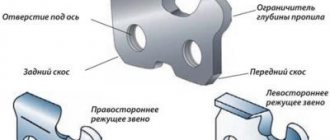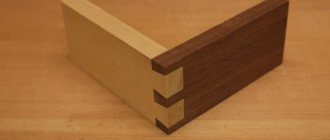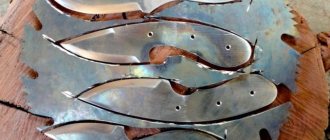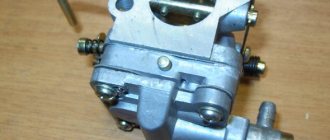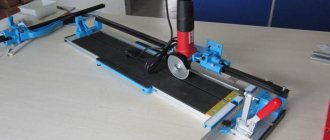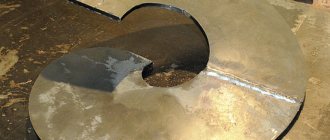A chainsaw is a necessary tool for household needs; it can find worthy use in the countryside. A chainsaw is easy to cut wood for a stove or fireplace. It also performs well when felling trees. Every owner of such an assistant should know the correct angle for sharpening chainsaw chains. Calling a specialist to your home, and especially to your dacha, costs a lot of money. Therefore, you have to make do on your own.
Although it is better to entrust sharpening to a professional, some lumberjacks have learned this craft on their own. If wood cutting specialists have to sharpen a chain 3-4 times a day, then an ordinary gardener does not have such a need due to the fact that he rarely uses the tool. How can you master the craft yourself? There are some recommendations for this.
TOP 5 best manual machines
Oregon 557849
A simple hand-held device suitable for sharpening saw chains in the field.
Oregon 557849 Advantages:
- high accuracy;
- easy fastening to the tire;
- ease of operation.
Flaws:
no file included.
Patriot manual CFG
A universal hand-held device weighing 730 grams, suitable for all types of chainsaws. It is possible to install round files of suitable diameters: 4.0 – 5.5 mm.
Average price: 1500 rubles.
Patriot manual CFG Advantages:
- good accuracy;
- Ease of use;
- quick attachment to a chainsaw.
Flaws:
- low productivity;
- labor intensity.
LUX-TOOLS
A universal mobile device made in Italy.
Characteristics:
| Parameter | Meaning |
| Weight, g | 417 |
| Height, mm | 275 |
| Width | 860 |
| Depth | 540 |
| Manufacturer country | Italy |
Average price: 1550 rubles.
LUX-TOOLS Advantages:
- ease of use;
- ease of attachment to the tire;
- good mobility.
Flaws:
low productivity.
DDE GT010B
A universal device under the American brand, made of anti-corrosion steel. Designed for processing without removal from the tire. Any files are suitable for repairs. Warranty period is one year.
Characteristics:
| Parameter | Meaning |
| Weight, g | 550 |
| Height, mm | 65 |
| Width | 165 |
| Depth | 290 |
| Brand | USA |
Average price: 1200 rubles.
DDE GT010B Advantages:
- low cost;
- ease of use;
- small sizes;
- reliable fastening to the tire;
- ease of transportation.
Flaws:
wing joints of parts of insufficient rigidity.
Champion C6500
A small hand-held quick sharpener directly on the bar. Fastened on both sides with reliable screws. The angle can be changed according to degree markings. Using the measuring pen, you can fix the saw element.
Characteristics:
| Parameter | Meaning |
| Weight, g | 550 |
| Height, mm | 60 |
| Width | 160 |
| Depth | 291 |
| Brand | Russia |
Price: 730 - 1050 rubles.
Champion C6500 Advantages:
- adjustment in any direction;
- sharpens limiting and cutting teeth;
- high angle accuracy;
- low vibration;
- low cost.
Flaws:
- no file included;
- some inconveniences during installation.
Why does the chain get dull?
There are several reasons why a chain becomes dull quickly for inexperienced users. This mainly happens for the following reasons:
- Using low-quality oil not recommended by the manufacturer;
- Incorrect setting of parameters, the gap between the edge and the limiter should be 0.7 mm;
- Lack of lubrication of the tool before work. Immediately before each use, lubricate the drive sprocket with M8 oil.
- There is no normal chain tension; during installation, it must be positioned exactly along the grooves located on the bar.
Chainsaw chain sharpening template
When purchasing a chainsaw, it is advisable to acquire a special template (see Fig. 3), with which you can easily set the optimal values of the tooth angles. It is used to control the values of the rear angles of the upper and end blades, as well as the front edge angle (it is indicated in the manufacturer’s instructions and can vary within 65...80°).
It is especially important to use a template to estimate the clearance angle of the upper blade. This chainsaw chain sharpening angle is otherwise very difficult to determine, and yet it must be maintained within fairly limited limits - from 50 to 60°
The sharpening angle is measured by determining the angle between the top cutting edge and a line perpendicular to the chain guide.
The sharpening angle of the chainsaw chain can be changed, depending on what work will be done. As the hardness of the wood increases, its value should decrease. In general, the optimal angle value is 10...12° for longitudinal cutting, and 25...30° for cross cutting.
Figure 3 – Appearance of a template for sharpening chainsaw teeth
Sharpening can be done manually using a round file with a working diameter of 4...5.5 mm, or on a machine
In the first case, it is extremely important to correctly position the tool relative to the tooth being sharpened. The upper edge of the working part of the file is located approximately a fifth above the upper edge of the tooth
The tool is positioned perpendicular to the chain axis, and at an angle of 25...30° to the upper edge of the tooth
One round file is not enough. To sharpen the limiter, you will need a flat file, and to clean the work area, you will need a hook that removes the sawdust that forms. There are also special holders on sale, on which the lines of direction of movement of the file relative to the chain axis are graduated. As can be seen from Fig. 4, the holder can be installed on the tooth from above, and rest on its upper edge. Since the height of the holder is adapted to a certain chain pitch, it should be selected in relation to chainsaws of specific models and brands.
The minimum required set to obtain the correct angle for sharpening a chain manually is shown in Fig. 5.
Figure 5 – Set of sharpening tools and accessories
First, the teeth of one direction are sharpened, and then the other. Start by lightly pressing the tool away from you, gradually increasing the load. During sharpening, the round file is periodically rotated along its axis.
Mechanized sharpening on a machine Sharpening on a machine is much more convenient and does not require highly qualified performers. Such machines are electrically driven and equipped with special grinding wheels. For a household workshop, it is worth purchasing compact units that do not take up much storage space and are suitable for quick and high-quality sharpening of chainsaw chains from different manufacturers
Such units should operate from a stationary power supply with a voltage of 220 V, have low power consumption (up to 100 W) and be easy to install on the circuit. When choosing a machine, you need to pay attention to the following technological characteristics: The ability to process teeth with different thicknesses of the upper edge and different chain pitches; The ability to adjust the sharpening angle, within the limits specified earlier; Availability of replaceable grinding discs; Constant value of the cutting width. The design of the machine is simple and includes a drive electric motor, a shaft with a seat for a sharpening disk, a handle with controls, and a device for attaching the machine to a chain. Adjustment of the pressing force on the sharpened element is ensured by a spring clamp
Modern models of sharpening machines are equipped with a differentiated clamp, which provides for self-centering of the product on the machine. For ease of work, there is a measuring scale on the clamp body. Optionally, the machines can also be equipped with a miniature electric light bulb, which illuminates the working area, as well as a hydraulic booster, which facilitates sharpening. Safety of work is ensured by a folding safety shield.
Taking into account the material from which the teeth are made
Most chainsaw chains use high-alloy chromium-nickel steel to make the cutting teeth.
Therefore, when purchasing a new copy, you should only visually check the quality of manufacturing of the cutting elements and their sharpening. However, to use the tool when processing particularly hard, frozen or heavily contaminated materials, it becomes necessary to harden the teeth. For such purposes, options are offered, on the teeth of which special carbide brazing is made.
Currently reading: How to sharpen a chain with a machine
Methods for sharpening chain saw blades
There are three types of sharpening a chain saw blade:
- Manual sharpening;
- On the machine;
- With the help of a grinder.
The most popular is the manual method, since, as a rule, all owners of chainsaws have the necessary tools. However, you should not use this method often, since it is difficult to accurately determine the angle of inclination, and incorrect sharpening will lead to rapid failure of the tool itself.
Manual sharpening with a file at home
The most popular way to sharpen a saw is to use a file or needle file. Usually 2 types are used - round and flat. The larger the chain pitch, the larger the diameter of the file or needle file. And the flat one can be of any size, because it is used as a limiter. Be sure to use a holder that is designed to hold a round file. With its help, filing will become correct, since the sharpening angle will be maintained. The sharpening angle varies for different types of saws from 25 to 35 degrees.
The sequence of work is as follows:
Install the file holder. Place the arrows on the bar parallel to the tire and check the sharpening angle. The upper blade is sharpened at an angle of 30°. We sharpen in the forward direction. Movements should be light and not sudden
It is important to remember that each tooth is sharpened the same number of times.
Experts recommend sharpening one side first and then moving on to the other. The negative side of this method is that if the sharpening angle is chosen incorrectly, the chain will be pulled to the side during operation. And this negatively affects the result of work and the functionality of the chainsaw in the future.
Professional sharpening on a machine
Sharpening on a professional machine is the most desirable, because it is distinguished by the accuracy of the work. In addition, you don’t need to make any effort to sharpen, the machine will do everything itself. To ensure accurate sharpening, you must use the included rulers and protractors. However, purchasing a machine will not be cheap. You can save money by contacting a specialized woodworking workshop.
Sharpening with a grinder
Sharpening with a grinder is not recommended for beginners, as it requires a lot of experience and skill. If you choose the wrong angle, you can easily ruin the chain, damaging the cutting elements. There are two ways to sharpen using a grinder. The first involves removing the chain from the chainsaw. The master fixes the grinder motionless and operates only with a chain, bringing each link separately.
PowerSharp technology
If your chain is PowerSharp compatible, you can save time and effort. Sharpening occurs without removal from the tire in just a few seconds. The system includes:
- sharpening device;
- abrasive bar;
- saw bar.
Let's figure out how to sharpen a chainsaw chain using PowerSharp in just three steps:
- Install the chain with the bar;
- Secure the beam installed directly on the tire;
- Place the end of the saw somewhere and run the equipment for a few seconds.
Sharpening with PowerSharp systemSource greenindustrypros.com
Compliance with all recommendations will allow you to avoid damage to the chain and carry out the operation in compliance with technological requirements.
Watch the video on how to sharpen a chainsaw chain using traditional methods:
Using a grinder as a chainsaw sharpening tool
You can sharpen a chainsaw chain with a grinder, although in this case you will need to be precise, since the use of this technique does not involve the use of limiters. The equipment is first secured to a workbench or table, for which it is better to make some kind of clamp. After securing the power tool, it is checked for vibrations. The secured power tool is checked for vibrations that would not be acceptable during precision operations. The sharpening technique involves passing the links along an abrasive wheel.
In addition, when using an angle grinder, there is still a risk of making several mistakes:
- the thickness of the removed layer is not controlled;
- there is a high probability of making mistakes when sharpening teeth;
- there is a danger of cutting through the connecting eyelet, the fixing links.
Sharpening with a grinder Source prosto-instrumenty.ru When securing the grinder with a clamp or vice, the disc is placed in a vertical plane. An alternative method is to hold the saw, rather than the grinder, in a vice while the tool is brought to it.
Basic mistakes beginners make when sharpening
There are a number of recommendations on how to sharpen a chainsaw chain to avoid common mistakes common to beginners:
- you need to make the same number of movements for each tooth;
- equal forces must be applied to all teeth to avoid unevenness;
- if the chain is too dull, then a file will not be suitable for the job and it is recommended to use an electric machine;
- The angle is set taking into account the direction in which the logs will be sawed in the future.
When using a file, you must take into account that it removes metal shavings from the chain as it moves forward.
Watch the video on how to sharpen a saw with a grinder:
It is recommended not to touch the surface of the teeth with it when performing a reverse movement. Mostly all chains are sharpened at an angle of 30°, but after completing the procedure you should check them with a template. They do this using the following algorithm:
- the template is applied to the chain;
- check how far the depth limiter protrudes;
- The limiter is trimmed with a flat file.
Typically, the depth distance at the limiter is 0.65 mm, but in general, if necessary, it can be varied within 0.45 - 0.80 mm.
How to sharpen a chain correctlySource mauro-gianvanni.ru
The concept of a step and its meaning
Chain pitch refers to the distance between any three rivets. In saw chains, this length characterizes the distance between the two cutting teeth relative to each other. The pitch size is also equal to the length between the vertices of two adjacent chain shanks (guide elements that fit into the groove of the bar). In order to correctly determine the chain pitch of a chainsaw, measure the distance between the axes of three rivets in a row.
Gasoline saw chain design.
There is a well-founded pattern that states that the greater the distance between the cutting teeth of the chain, the deeper they go into the material being cut. By increasing the pitch of the chainsaw chain, you can increase its performance. In this case, the force for rotating the drive sprocket changes accordingly. You need to understand that the higher the step, the more force must be applied to pull it while cutting the material and the greater the engine power must be.
Modern manufacturers of gasoline saws use three main types of sawing chains with the following pitch values, measured in inches:
- 0.325;
- 0.375 (marking 3/8 is used in classification);
- 0.404.
The quality and accuracy of the cut created in the material depends on the chain pitch. If the quality of cutting when working with a chainsaw is not of global importance, then the accuracy of the cut is sometimes important when dissolving logs or boards; for this, you need to take into account the dependence of the saw pitch on dissolving the wood according to given markings.
File position when sharpening a chainsaw chain.
The higher the distance between the teeth, the more vibrations and parasitic forces arise, tending to displace its working tire in different directions, and the rougher the cut created due to ruptures of wood fibers. Accordingly, the effort required to hold the saw in your hands increases.
The rule for selecting a chain indicates that the pitch between the teeth is directly proportional to the performance and power reserve of the motor and inversely proportional to the accuracy of the cut being created.
Useful tips
Some helpful tips will help keep your equipment in working order and eliminate the risk of injury. Of course, it is necessary to know the correct angle of sharpening the chain of a Shtil chainsaw. But timely tire care is also important:
- It is necessary to control the chain tension. Especially if the chainsaw tilts to one side during operation. Poor tension can pose a threat to humans.
- Conduct sharpening in a timely manner, without putting everything on the back burner. It may be expensive, but it is better to give preference to electrical equipment.
- Regularly lubricate the entire chain, otherwise it may fly off (its speed is about 100 km/h). Everyone will draw their own conclusions.
- Do not use used motor oil or any product of questionable quality. You should only choose specialized lubricants. As the best remedy - autol.
Before you start using a chainsaw, the chain should be broken in. Let it run at minimum speed for 40-50 seconds. The lubricant will reach every part, and the chains with the sprocket will heat up a little and rub against each other.
All this expert advice should not be ignored if you want to remain safe and sound!
Popular manufacturers
The modern market is full of offers from manufacturers. But there are companies that are time-tested. It is their products that are preferred by owners of circular saws. A short list of popular brands is as follows:
CMT. The company appeared in Italy back in 1962. Production was moved to China, and only the head office remained in Europe.
"Makita". The year the company was founded was 1915. Much time has passed since then, but Japanese products are still popular all over the world.
"Bosch". This name has long been a symbol of unsurpassed quality. Saw blades under the Bosh brand are welcome guests in every home workshop.
"Attack". The organization appeared in 1998 in Russia. It can rightfully be called the oldest supplier of consumables on the domestic market.
Metabo. The name comes from the German name for a hand drill. The assembly of the first products began in Germany after 1924.
Dewalt. The company's victorious march around the planet started in the USA. Since 1922, the brand has produced accessories for power tools.
Advanced technologies are not easy to understand. Tooling manufacturers are constantly improving their production. We invite you to watch a video that will help you make the right choice and learn a lot of useful information:
Electric and manual sharpening machines
High-quality sharpening of a chain with a file is not always possible during long-term operation of the mechanism without regular maintenance or when the teeth often come into contact with stones and other hard parts of the ground, during which they become significantly deformed and lose their shape. In this case, electric and manual machines are used. The former are equipped with sharpening wheels driven by electric current, while the latter are a type of mechanical device.
The operating principle of manual sharpening machines is reminiscent of a bow-type saw, in which instead of a blade, a round file of the appropriate length is attached. A rather intricate device for mechanical adjustment makes it possible to position the tool with the desired orientation to the smallest control tooth, which is sharpened in several movements.
The sharpening angle parameters are saved when correcting the next cutting element, thus, not only sharpening is carried out quickly and efficiently, but also the chain is straightened to a uniform tooth size. To process the limiter with a manual machine, it is necessary to insert a flat tool instead of a round file.
The use of an electric machine greatly facilitates and simplifies the process of performing work. The sharpening angle on this unit is ensured by a precise adjustment system, which allows you to bring the grinding wheel with a correct orientation directly to the cutting edge of the surface being processed, while the tire is automatically fixed.
Sharpening by machine
The most effective method is considered to be using an electric machine, which allows you to achieve factory accuracy. Let's figure out how to sharpen a chainsaw chain in this way, achieving the desired result with minimal time and labor costs. The saw is placed in a special hole. It is necessary to loosen the screw that clamps the chain and adjust the desired level of sharpening according to the tables or the bluntest tooth. The process is carried out in accordance with the selected parameters, after which the saw is treated with machine oil. You can use two methods when sharpening with a machine:
- Consecutive action on the teeth one after another, changing the polarity from time to time.
- The teeth are sharpened one at a time, first the right and then the left, which makes it possible to do without changing the polarity.
Sharpening a chain with a machine Source instrumentgid.ru
Watch the video for instructions on sharpening a chainsaw chain using a machine:
Chainsaw chains. How to choose? How is it arranged? Video.
What distinguishes professional lumberjacks from those new to this business is that the former understand exactly how to determine the quality of a chainsaw. It makes little sense to take into account the power of the device alone, since the configuration of the cutting element is of decisive importance. In the case of a chainsaw, this element is a chain, which consists of cutting, driving and connecting links. The cutting link includes a depth limiter and the cutting part itself, the operation of which is somewhat similar to a plane, that is, the thickness of the chips depends on how far the upper edge is extended. The leading link takes on the function of rotating the chain along the groove and distributing the lubricant, and the connecting links are designed to connect the remaining elements of the chain to each other. Their construction always takes place at a strict angle, the same applies to subsequent sharpening, since the slightest change in the angle in one direction or another will lead to the chainsaw not working.
The first time such tools began to be used back in 1920, but then the teeth were flat and straight, which could not but affect the final cutting result, and it was quite difficult to work with such a saw. A certain breakthrough in this area occurred in 1947, when a fundamentally new type of chain teeth was introduced - the L-shaped shape made it possible to cut the material much faster, in addition, the process of sharpening the teeth was simplified, so it is not surprising that the invention of Joseph Cox, who proposed such idea, in a short time it became a sales leader. If we consider our days, then almost the same version of the chainsaw has reached us, which is based on a chain system with a crescent-shaped cutting profile, for which the type of wood does not play a significant role.
Selection by link type
The cross section of a chisel-type link is shaped like the number 7. Experience in operating such chains shows that they provide high productivity and high-quality cutting of wood. With this profile, the working section of the link has a straight surface, which allows it to be evenly embedded in the material being cut.
Chainsaw attachment for longitudinal sawing attachment for. The disadvantages of chisel options include the difficulty of sharpening. Even small deviations from the specified profile angles significantly reduce cutting performance. In addition, during operation, closed areas arise, which become an accumulation of dust and dirt.
Comparative table of characteristics of electric chain saws.
The cross section of a chippel type link is shaped like a sickle. The working area of the link does not have pronounced angles - they are rounded. Technical characteristics of the partner 350 chainsaw. The partner 350 s is considered the most common saw from the “partner” series. This model is used for longitudinal and cross cutting of wood.
Due to this, the total area of the working area increases, which leads to increased loads during sawing and somewhat reduces the functionality of the cutting element
At the same time, the chippel type gains advantages when sharpening teeth, since it does not require strict adherence to dimensions and angles, and also does not have the disadvantage associated with the accumulation of dirt and dust, which is important when working with wood
In order to reduce the cost of chains, they can be made with omission or semi-omission of cutting links. When semi-skimming, additional connecting links are installed in every second pair of cutting teeth. When skipping, additional links are installed after each cutting tooth. In a standard chain, the number of cutting teeth is 50% of all tails, in a half-skip - 40% and in a skip - 37.5%. Naturally, the load on the cutting teeth increases, and they fail much faster.
How to sharpen a chainsaw chain at home with a file
A tool with an exclusively round cross-section will help to properly sharpen a chainsaw chain with a file. The file parameters are determined by the dimensions of the saw itself
It is important to know the tooth pitch. One round sharpener is not enough
For sharpening and straightening chains, two types of tools are used. The first is a round file with a diameter corresponding to the rounding diameter of the working edge of the saw tooth. To process the cutting depth limiter of the guide tooth, a flat file is needed.
Sharpening can be done manually using a round file with a working diameter of 4...5.5 mm
It is extremely important to correctly position the tool relative to the tooth being sharpened. The upper edge of the working part of the file is located approximately a fifth above the upper edge of the workpiece
The tool is held perpendicular to the chain axis at an angle of 25º…30º to the upper edge of the tooth.
To sharpen saw chains of household tools, round files with a diameter of 4 and 4.8 mm are used, since they have a small tooth. For professional models, more powerful chains with larger teeth are used. Therefore, files with a diameter of 5.2 and 5.5 mm are needed.
To sharpen the limiter, you will need a flat file, and to clean the work area, you will need a hook that removes the sawdust that forms. There are also special holders on sale, on which the lines of direction of movement of the file relative to the chain axis are graduated. The holder can be installed on the tooth from above, resting on its upper edge. Since its height is adapted to a certain chain pitch, this device should be selected in relation to chainsaws of specific models and brands. The minimum required set to obtain the correct angle for sharpening a chain manually is shown in the photo.
Set of sharpening tools and accessories PHOTO: proinstrumentinfo.ru
Manual sharpening saves material resources and allows you to perform work in the field. First you need to install the tool on a level surface. If the work is done in the forest, large-diameter logs are well suited for this. Next, you need to inspect the saw chain for any defects, these could be cracks or completely broken teeth. After inspection, you need to set the brake to working condition, thereby blocking movement along the chain bar, which must be tensioned during sharpening with a file.
File for sharpening chainsaw chains: types and tips for choosing
The diameter of the round file is selected according to the pitch of the saw chain. Pitch values of 1.3 and 1.6 mm correspond to files with a diameter of 4 and 5.2 mm. A flat tool will be needed to reduce the height of the cutting link stops.
How to properly sharpen a chainsaw chain with a file
Templates and patterns must be secured to the area to be treated. They will give the file the right direction, making the process easier. When all the preparatory work has been done, you can proceed directly to sharpening the chain.
According to the rules, you need to sharpen the teeth in one direction, then in the other. The work begins with light pressure with a file in a direction away from you, the pressure gradually increases. Reverse stroke of the file - without pressing. A round tool must be continuously rotated along its axis. The chain is sharpened by moving from the inside of the tooth outwards. In this case, the file must be positioned parallel to a special mark on the chain, which is applied by the manufacturer to indicate the standard sharpening angle.
The tooth to be sharpened should be located approximately in the middle of the tire; this is necessary for ease of work. During processing, you need to move the chain along the bar, not forgetting to set the brake to the working position each time.
The angle of inclination of the tool must be straight, and the sharpening angle of the chainsaw chain horizontally must be sharp, and its changes are allowed in the range from 10º to 30º. The smallest tooth in the row should be taken as a basis. Turn the tire over and do the same work for the teeth that go in the opposite direction. The disadvantage of this sharpening method is that it takes a lot of time.
Sharpening a chain with a file PHOTO: proinstrumentinfo.ru
You can insert a round file with a broken handle into the chuck of an electric drill or screwdriver. The result is a very convenient mechanized sharpening device.
Sharpening a chain with a drill and file PHOTO: youtube.com
External signs of a dull cutting edge of a chainsaw tooth
Let us recall that a chainsaw tooth has a complex configuration (see Fig. 1), which also depends on the direction of movement of the chain. It has two working edges: a side edge, which is located perpendicular to the axis of movement of the links, and an upper edge, located at a certain angle to the direction of movement of the chain. In addition, a limiter is provided on each tooth, the parameters of which determine the height of the chips removed. Since the main cutting force falls precisely on the working angle, all subsequent work with the tool will depend on the angle to which the tooth is sharpened.
Figure 1 – Functional parts of a chainsaw tooth and their appearance
Before starting long-term work with a chainsaw, it needs to be inspected and test sawed, as a result of which:
- Visually determine the presence (or absence) of a conical section adjacent to the corner of the tooth, as well as a radius rounding on it - the main signs of blunting (see Fig. 2).
Figure 2
- Check the feed force at which the tool operates steadily and produces a quick cut. For sharp teeth, the initial moment of penetration of the tooth into the wood occurs quickly, and without significant resistance to the material.
- Find out the presence of chain vibrations during a steady cut - if they are noticeable, then the teeth need to be sharpened.
- Inspect the appearance of the newly cut end (especially if the tool is used for rip sawing). If there are rough chips and dents, the chainsaw chain must be sharpened.
Tables of saw chain and chainsaw bar sizes by model
This is a defining parameter, and depending on its value, all existing chains are divided into five groups with pitches of 1/4'', 0.325'', 3/8'', 0.404'' and 3/4''. Step 1/4'' ' (6.35 mm) is typical for small chains installed on low-power one-handed saws.
0.325'' (8.25 mm) and 3/8'' (9.3 mm) pitch chains are the most common options. More than 80% of saws produced around the world are equipped with them.
0.404'' (10.26mm) and 3/4'' (19.05mm) pitches feature larger link chains for increased performance. For several decades, they were equipped with Russian-made saws, but now they are installed only on powerful felling saws and harvesting equipment.
The larger the chain pitch, the larger the links that make it up and the higher its performance, but the wider the cut. To overcome the increasing cutting resistance, a more powerful saw is required. Chains with a small pitch have other advantages - a larger number of teeth per unit length, smooth movement in the cut and, accordingly, reduced vibration, a cleaner cut.
Drive link thickness. During operation, the chain slides in the groove of the bar, and this sliding should be smooth, without snagging and at the same time without unnecessary “bumpiness”. The thickness of the shank and the thickness of the groove must strictly correspond to each other, which increases the reliability of the chain fit and eliminates the possibility of it “jumping off.” Everything is provided in five standard sizes:
- 1.1 mm (0.043'') for low power saws
- 1.3 mm (0.050'') household and semi-professional chains,
- 1.5 mm (0.058'') powerful and productive saws,
- 1.6 mm (0.063'') and 2.0 mm (0.080'') highly professional saws.
The purpose of use imposes its own requirements on the circuits used. For example, if you need to saw hard and contaminated wood or during demolition and construction of structures, it is better to use special carbide chains Picco Duro or Rapid Duro, which have carbide teeth or linings, giving them unsurpassed strength and durability. Some jobs simply cannot be completed without their help.
It is also known that for longitudinal sawing of wood (along the grain) it is advisable to use special chains. The main difference between longitudinal and transverse type chains is the angle of attack of the cutting links. For crosscut chains they are 25–35 degrees. Ripping chains (such as the Stihl Picco Micro X chain) have sharper angles - from 5 to 15 degrees.
The use of chains inappropriate for their purpose leads to either reduced performance or increased “aggressiveness”, strong vibration and additional load on the chainsaw engine.
Additional characteristics of the chain are the profile height and cutting depth.
Profile height.
Chains are available in high and low profile depending on the height of the cutting edge above the plane of the guide bar. High profile chains are usually used for professional purposes to achieve maximum sawing performance. Low-profile chains are installed on household and amateur chainsaws, because... Thanks to the increased support area of the cutting links and the reduced thickness of the cut chips, they are safer.
The depth of cut is the amount of clearance between the top edge of the tooth and the cut stop, which regulates the thickness of the chips. Most often, there are samples with gaps of 0.025 inches (or 0.635 mm) and 0.030 inches (or 0.762 mm), less often - with gaps up to 0.07 inches (or 1.778 mm), the latter are intended for machine felling units.
Chain length accounting
The length of the chain depends entirely on the parameters of the chainsaw itself: dimensions, sprocket sizes and power. With a standardized tension, the length for a specific chainsaw is determined and indicated in the passport.
Another question is the number of links, i.e. number of cutting teeth at this length. This parameter completely depends on the pitch of the links. Thus, the problem of how to select a chain taking into account the length is solved in complex, taking into account the pitch of the links. In general, increasing the length requires increasing the power of the chainsaw, but increases productivity.
Currently reading: Adjusting the Carburetor of the Stihl MS 250 Chainsaw

